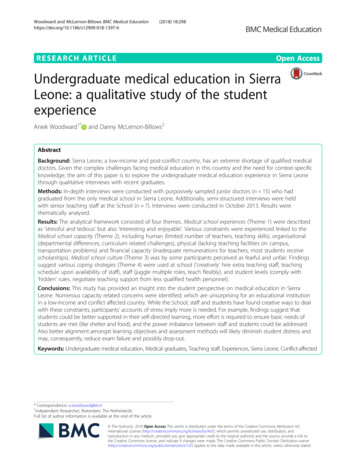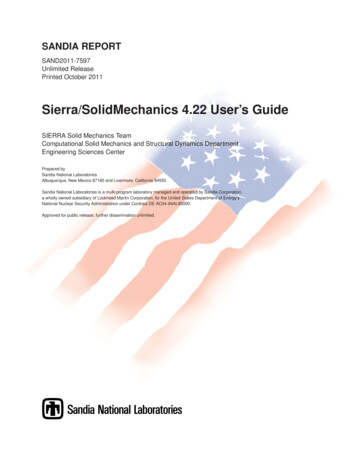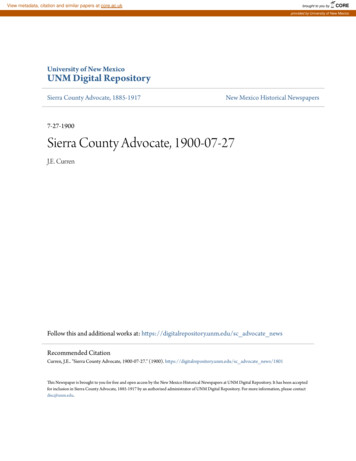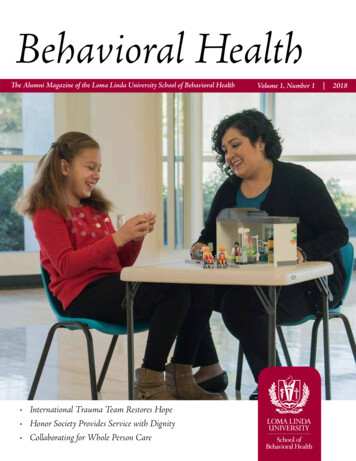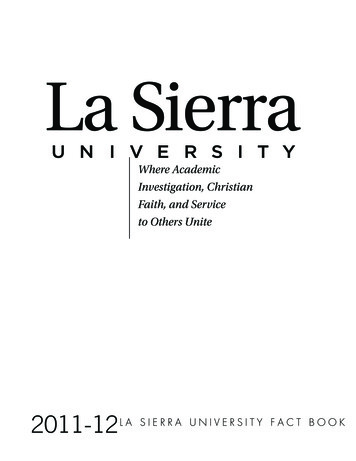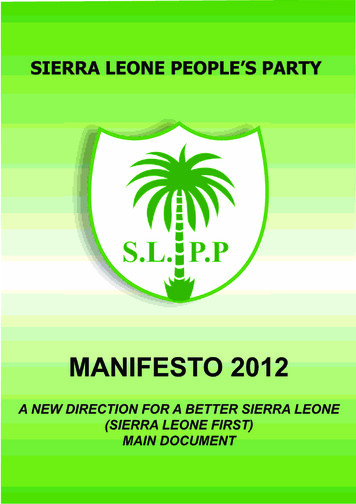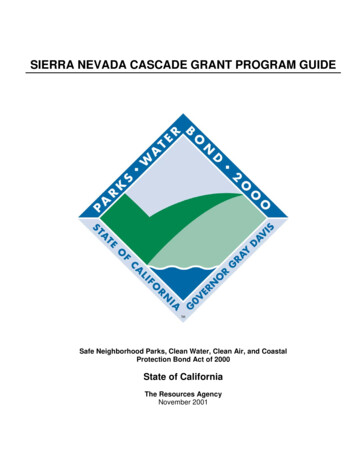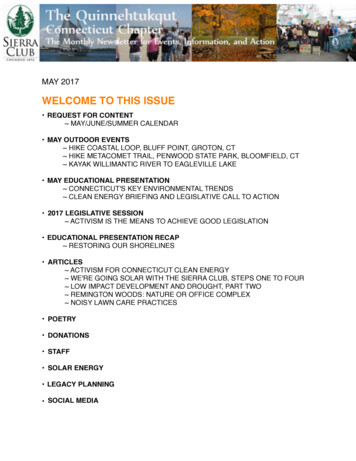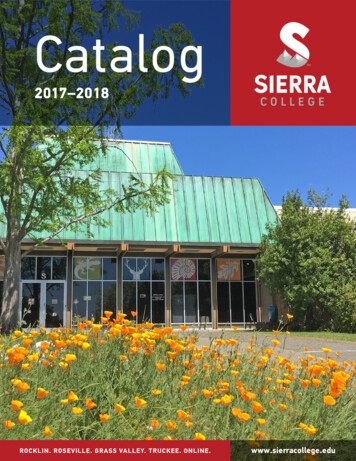
Transcription
Catalog2017–2018ROCKLIN. ROSEVILLE. GRASS VALLEY. TRUCKEE. ONLINE.www.sierracollege.edu
Sierra CollegeTABLE OF CONTENTS1Health Education . 128Health Sciences . 129Table of Contents . 1History . 132About Sierra . 3Human Development and Family . 135Locations and Contact Information . 3Humanities . 142District Mission and Institutional Outcomes . 3Interdisciplinary . 145Academic Calendar . 4Italian . 145A Brief History of Sierra College . 5Japanese . 146General Information . 6Kinesiology . 146Board of Trustees . 7Learning Disabilities . 153Departments . 8Lesbian, Gay, Bisexual and Transgender Studies . 154Administration of Justice . 8Liberal Arts . 155Agriculture . 14Library Science . 157Anthropology . 17Mathematics . 157Applied Art and Design . 19Mechatronics . 163Art . 26Music . 165Art History . 31Natural Science . 170Astronomy . 33Nursing Assistant . 171Athletics . 34Nursing, Registered . 172Automotive Technology . 38Nutrition and Food Science . 175Biological Sciences . 43Perceptual Training . 177Business . 52Personal Development . 178Chemistry . 59Philosophy . 180Communication Studies . 63Photography . 182Computer Information Systems . 66Physics . 187Computer Science . 72Political Science . 190Construction and Energy Technology . 76Psychology . 192Deaf Studies . 81Recreation Management . 196Drafting and Engineering Support . 83Rise . 199Drama . 86Skill Development . 199Earth Science . 90Social Science . 200Economics . 94Sociology . 202Education . 95Spanish . 205Engineering . 97Welding Technology . 208English . 100Women and Gender Studies . 212English as a Second Language . 107Student Resources . 215Environmental Studies and Sustainability . 111Admission and Enrollment . 215Fashion . 113Admission . 215Fire Technology . 115Getting Started at Sierra College . 216French . 123Student Enrollment and Attendance . 220Geography . 124Transfer of Credit to Sierra College . 221German . 128Student Services and Support . 224Sierra College Catalog 2017-2018
2Table of ContentsFinancial Aid . 224Student Services and Resources . 226Student Activities . 231Associate Degree and Certificate Information . 232Associate Degree and Certificate Programs . 234General Education Options . 236Sierra College Associate Degree Requirements 2017-2018 . 236California State University General Education BreadthRequirements 2017-2018 . 244Intersegmental General Education Transfer Curriculum2017-2018 . 250Jeanne Clery Disclosure of Campus Security Policy and CampusCrime Statistics Act . 294Non-Discrimination Policy . 294Pass/No Pass Grading . 294Posting of Materials . 294Prerequisites, Corequisites and Advisories . 294Prohibition of Harassment . 295Remedial Coursework Limit . 295Smoking, Use of Tobacco, Non-Regulated Nicotine and OtherVapor Producing Products on Campus . 295Speech: Time, Place and Manner . 296Course Information . 255Student Course Repetition . 296Understanding Course Descriptions . 255Student Records . 297Limitations on Active Participatory Courses . 257Student Right-to-Know Disclosure . 297Course Identification Numbering System (C-ID) . 259Title IX Information . 297Transferable Courses to the CSU System . 261Transcripts . 298Transferable Courses to the UC System . 273Transfer Articulation Agreements . 298Academic Standards, Policies, and Procedures . 279Use of Copyrighted Material . 298Students' Rights and Responsibilities . 280Visitors on Campus . 298Definitions . 280Weapons on Campus . 299Honesty in Academic Work . 281Administration, Faculty, Staff, and Emeritus . 299Standards of Student Conduct . 282Index . 321Student Discipline Procedures and Due Process . 283Copyright and Publication Information . 323Disciplinary Appeal Procedures . 284Students' Rights and Grievances . 285Academic Freedom Policy . 287Academic Honors . 288Academic Renewal . 288Academic Standing . 288Auditing Courses . 289Computer and Network Use . 289Courses Designated as Repeatable . 290Credit By Examination (Challenge Petition) . 290CSU GE-Breadth and IGETC Certifications . 290Directory Information . 290Disabled Students Programs and Services AcademicAccommodations Policy . 291Drug-Free Environment . 291Grade Changes . 292Grade Points and Units . 292Grading and Academic Record Symbols . 293Incomplete Academic Work . 293Sierra College Catalog 2017-2018
Sierra CollegeABOUT SIERRA District Mission and Institutional Outcomes (p. 3) Academic Calendar (p. 4) A Brief History of Sierra College (p. 5) General Information (p. 6) Board of Trustees (p. 7) Administration, Faculty and Staff (p. 299) Locations and Contact Information (p. 3)Locations and Contact InformationSierra Joint Community College DistrictRocklin Campus3thoughtful application of knowledge guided by respect for others and theworld in which we live.Core ValuesThe following core values will establish our ethical principles and willguide our institutional decision-making. Sierra College will:1. Support and model excellence in teaching, learning, scholarship, andcreativity.2. Provide the tools for continuing success in an ever-changing world.3. Provide and demonstrate the value of an inclusive and equitablecommunity.4. Demonstrate collaboration in decision making.5. Foster active citizenship in our community, our nation, and our world.6. Create and nurture meaningful connections to our community.7. Recognize that students are active participants in their education.5100 Sierra College BoulevardRocklin, California 95677(916) 624-3333Reference: Sierra College Board Policy 1200Nevada County policies/index.php250 Sierra College DriveGrass Valley, California 95945(530) 274-5300Student Learning Outcomes8. Support and demonstrate the sustainable use of all resources.316 Vernon StreetRoseville, California 95678(916) 781-6200Student learning outcomes state the expected knowledge, skills, andabilities students possess as a result of utilizing services and completinga course, a certification or a degree. At Sierra College, instructionalprograms define student learning outcomes for their content areas andlink them to courses, certificates and degrees. Student learning outcomesfor individual programs may be found on the Sierra College website.Course student learning outcomes are included in the class schedule.The general education sequence supports students’ attainment of thecollege’s institutional outcomes, as do the student learning outcomes forstudent services. These outcomes align with our district mission, supportour vision, and reflect our core values.www.sierracollege.eduInstitutional OutcomesTahoe-Truckee Campus11001 College TrailTruckee, California 96161(530) 550-2225Roseville CenterDistrict Mission and InstitutionalOutcomesMission StatementSierra College provides an academic environment that is challengingand supportive for students of diverse backgrounds, needs, abilities,and goals with a focus on access, equity, student-centered learning,and achievement. The college is committed to practicing diversity andinclusion, and recognizes that a diverse and inclusive curriculum andworkforce promotes its educational goals and values. Institutionallearning outcomes guide the college’s programs and services,encouraging students to identify and expand their potential by developingknowledge, skills, and values to be fully engaged and contributingmembers of the global community. Sierra prepares students by offeringAssociate’s and transfer degrees, certificates, career and technicaleducation, foundational skills, as well as lifelong learning and enrichment.Vision StatementWe will challenge ourselves and our community to become fulfilledcitizens in a global environment by contributing to and engaging in theStudents attend Sierra College for a variety of reasons. Based on theirown educational goals and experiences, students will develop skills in thefollowing areas:Communication1. Read—Use active reading skills to comprehend and interpretinformation and ideas from a variety of texts, including academicprose (such as textbooks, literature, primary and secondary sources,and scholarly journals), technical documentation (such as manuals,charts, graphs, and reports), and media sources (such as newspapers,magazines, websites and online databases).2. Write—Communicate thoughts, ideas, and information effectively inwriting in a variety of modes and for a variety of purposes. Accuratelyand persuasively convey information and ideas using logic, reasoning,and effective rhetorical strategies. Use correct grammar, spelling,punctuation, diction, style, and format.3. Listen—Demonstrate active listening skills in classroom, community,personal, and professional situations. Interpret and respondappropriately to verbal and nonverbal communication in a variety ofcontexts.4. Dialogue—Interact in a variety of dynamic situations by assessingthe needs of the audience, creating a message, adapting to audienceSierra College Catalog 2017-2018
4Academic Calendarfeedback, and responding appropriately. Through dialogue, buildmutual understanding with individuals from various backgrounds.September 4Last Day to Drop from Full-Semester Class withoutReceiving a "W"Technology and Information Competency1. Demonstrate Technical Literacy—Efficiently and accurately usecurrent computer and other relevant technologies to acquire, process,and present information. Organize and maintain records.2. Apply Technology—Use computer applications and othertechnologies in the learning process, real-world scenarios, and theworkplace. Organize and maintain records.3. Access Information—Recognize the need for information; chooseand narrow topic. Formulate search questions. Gather, organize, anddiscriminate among various sources of information.4. Evaluate and Examine Information—Filter information for relevanceand accuracy. Apply criteria to determine credibility. Utilize datagathered to draw conclusions. Construct meaning from expandingand conflicting information. Credit sources according to academicstandards.Critical and Creative ThinkingLast Day to Add Full-Semester ClassLast Day to Drop from Full-Semester Class andReceive a RefundSeptember 5Census DateSeptember 15Deadline to Initiate Credit By Examination (Challenge)September 22Last Day to Request Pass/No Pass Grading for FullSemester ClassOctober 1Last Day to Request December 2017 Degree orCertificateOctober 30Last Day to Withdraw from Full-Semester Class andReceive a “W”November 10-11 Holiday (Veterans Day)November 23-25 Holiday (Thanksgiving)December 9Semester EndsDecember 21January 1Campus Closed1. Inquire—Identify and understand questions or problems acrossdisciplines and in practical applications. Develop hypotheses.Spring Semester 20182. Analyze—Investigate and assess the validity or relevance ofarguments, claims, or contentions supported by data, observation,experience, testing or analysis. Distinguish fact from opinion. Developan interpretation with an awareness of different views and reasoning.January 15Holiday (Dr. Martin Luther King, Jr. Day)January 22INSTRUCTION BEGINSFebruary 4Last Day to Add Full-Semester Class3. Problem Solve—Use sound reasoning to specify solutions andconsequences. Test hypotheses using methods appropriate to theproblem (such as the scientific method, mathematical reasoning, andprinciples of logic).4. Express—Acquire an appreciation and involvement in the creation orperformance of works of fine art, craft, music, drama, and/or culture.Participate in games, sports, dance, and outdoor pursuits based onindividual interests and capabilities.CitizenshipLast Day to Drop from Full-Semester Class withoutReceiving a “W”Last Day to Drop from Full-Semester Class andReceive a RefundFebruary 5Census DateFebruary 15Deadline to Initiate Credit By Examination (Challenge)February 16-19Holiday (Presidents' Weekend)February 26Last Day to Request Pass/No Pass Grading for FullSemester ClassMarch 11. Ethics—Develop and apply ethical reasoning and decision makingskills in academics, in the workplace, and in global and localcommunities. Value honesty, civility, empathy, interpersonalcompetence, social responsibility, and peaceful conflict resolution.Last Day to Request May and/or August 2018 Degreeor CertificateMarch 26-31Spring BreakApril 132. Diversity—Recognize, understand, and respect diversity of belief,culture, value, ability, gender, race, age, and sexual orientation.Last Day to Withdraw from Full-Semester Class andReceive a “W”May 17Commencement—Nevada County CampusMay 18Commencement—Rocklin CampusMay 19Semester EndsMay 28Holiday (Memorial Day)3. Sustainability/Global Awareness—Develop values and behaviors thatrespect the natural environment. Evaluate social justice issues andidentify social responsibilities to elicit social change. Recognize theethical implications of political, social, and economic institutions.4. Personal Responsibility—Accept personal responsibility byrecognizing oneself as the principal cause for opportunities andexperiences. Effectively develop, apply and manage a healthyphysical lifestyle and emotional well-being; self-motivate throughplanning and acting to accomplish goals. Recognize the value of lifelong learning.Academic CalendarFall Semester 2017August 21INSTRUCTION BEGINSSeptember 2-4Holiday (Labor Day)Sierra College Catalog 2017-2018Summer 2018June 11INSTRUCTION BEGINSJuly 4Holiday (Independence Day)August 4End of Summer ClassesThis calendar is subject to change.Each short-term or fast-track class has its own add, drop, withdrawal,refund, and pass/no pass grading deadlines. Contact a campusAdmissions and Records office or check the Sierra College website forregistration information.
Sierra CollegeReference: Sierra College Board Policies/Administrative ProceduresChapter 4.nearly 14,000, and, by the year 2000, the college enrolled approximately18,000 rd/policies/index.phpIn 1996, the 105-acre Nevada County Campus was opened. Twelvelocations had been considered in that county until property betweenGrass Valley and Nevada City was chosen.A Brief History of Sierra CollegeThe origin of Sierra College is somewhat uncertain. Some have said thatthe College may have begun with the establishment of Sierra NormalCollege and Business Institute in 1882. It was a small, private collegeat the location of today’s Placer High School in Auburn. Most think thatSierra College is an outgrowth of the Placer Union High School District.In 1914, the Placer Union High School District was born, stretchingfrom Loomis to Lake Tahoe. That same year, college-level classes wereoffered. The new college was named Placer Junior College. It was thefourth oldest junior college in California at the time and only one of ninestatewide; the faculty numbered four.Due to enrollment loss caused by World War I, Placer Junior College wasabandoned by 1920, but the college idea never completely died. In 1936,the college was reestablished, again in Auburn, with the enthusiasticsupport of local voters. It is 1936 that Sierra College uses as its officialdate of birth.Three wings of buildings were constructed to serve primarily PlacerJunior College, but Placer High School students shared many of thefacilities, instructors and organizational structure with the new college.Enrollment numbered about 100 and the college athletes went by thename “Spartans.” The college grew steadily and by 1938, 200 studentswere enrolled.Enrollment crested at 282 in 1939, but events quickly overtook thecollege in the 1940s. The 1941 attack on Pearl Harbor essentially endedenrollment by men as many went off to serve their country. Additionally,enrollment dropped significantly when Japanese-Americans were forcedinto internment camps. The student population dropped to 53 by 1943.The college eliminated the “Junior” from its name, becoming PlacerCollege.The war’s end brought returning veterans, the end of internment, and theGI Bill of Rights. Enrollment in the post-war years exploded as a result.1946 saw 467 students—about half were veterans. 856 were enrolledin 1949 and the Placer College facility was bursting at the seams. TheCollege had reached full capacity, and efforts to find a new collegelocation began. Area population continued to grow and the need for newfacilities grew acute. In 1953, Placer College was renamed Sierra Collegeand its athletes gained a new nickname—the “Wolverines.”In 1957, the new Sierra Junior College District successfully passeda bond measure to pay for new facilities. In 1958, a site selectioncommittee considered thirty-five possible locations and the presentRocklin site was chosen.By 1961, the new Rocklin campus opened and enrollment reached 1,500.In 1962, Nevada County joined Placer County in forming a huge newSierra Junior College District, which then had more square miles—3,200—than students.Enrollment boomed in the 1960s. By the end of the decade, Sierra Collegeboasted 100 full-time faculty members and nine new campus buildings.Enrollment was nearly 4,000. However, as fast as new facilities could bebuilt, they were filled. The next several decades saw significant studentpopulation growth. From 1970 to 1990, enrollment jumped from 4,000 to5Leased centers were opened in the Tahoe/Truckee and Roseville areas.Classes were also taught at local high schools and community centers.In recent years, successful bond issues provided for an expansion of theNevada County Campus and the creation of a permanent Tahoe-TruckeeCampus. In 2008, the Tahoe-Truckee campus inaugurated its brand-newfacilities. Located on beautiful McIver Hill next to Interstate 80, the stateof-the-art “green” campus overlooks historic Truckee. In 2008, a newMathematics and Technology Building was constructed on the Rocklincampus.In 2010, as the result of the passage of the voter-approved Measure GBond in November 2004, new buildings on the Nevada County Campusopened, including a computer lab and buildings for the arts and publicsafety.Sierra College continues to be in the vanguard of innovative projects.The award-winning mechatronics training program is a national leader incutting-edge electronics and robotics.Beyond the classroom, Sierra College operates an outstanding NaturalHistory Museum. Specializing in evolution and paleontology, the museumis open to the public with its high-quality displays and hosts thousandsof visitors annually, including attendance at the yearly Dinosaur Daysevent. The Sierra College Press functions as the only complete academicpress operated by a community college in the United States. It oftenco-publishes with Heyday, an award-winning California publisher inBerkeley. The Associated Students of Sierra College (ASSC) partnerswith college-wide programs and student clubs to cosponsor numerousmeaningful activities on campus that celebrate environment, humancultures, political awareness, gender and sexual equality, and many otherimportant issues. Student athletes compete in numerous intercollegiatesports within the California Community College Athletic Association,the Big 8 Conference and the Northern California Football Conference.Men and women student athletes have earned eight California StateChampionships for Sierra.Sierra College’s outstanding academic reputation, excellent technologiesand training programs, and updated facilities led to increases in studentenrollment. Projections of future “for credit” enrollment top 25,000.The Sierra Community College District includes all of Placer and NevadaCounties and part of El Dorado and Sacramento Counties. In recent years,Placer and Nevada Counties have been two of California’s fastest growingareas.The College District continues to experience dramatic growth andchange. The future is bright as new technologies evolve, offering greatereducational accessibility for students—both today and tomorrow.Since its first days, the promise of Sierra College has been to provide achallenging and supportive learning environment for students havingdiverse goals, abilities, and needs interested in transfer, career andtechnical training, and lifelong learning. The College continues thismission as it adapts to meet the ever-changing needs of students.Sierra College Catalog 2017-2018
6General InformationGeneral InformationAccreditationSierra College is accredited by the Accrediting Commission forCommunity and Junior Colleges (ACCJC), which operates under theWestern Association of Schools and Colleges, an institutional accreditingbody recognized by the Council for Higher Education Accreditation andthe United States Department of Education.Contact information:The Accrediting Com
Sierra Joint Community College District Rocklin Campus 5100 Sierra College Boulevard Rocklin, California 95677 (916) 624-3333 Nevada County Campus 250 Sierra College Drive Grass Valley, California 95945 (530) 274-5300 Tahoe-Truckee Campus 11001 College Trail Truckee, California 96161 (530) 550-2225 Roseville Center 316 Vernon Street Roseville .


